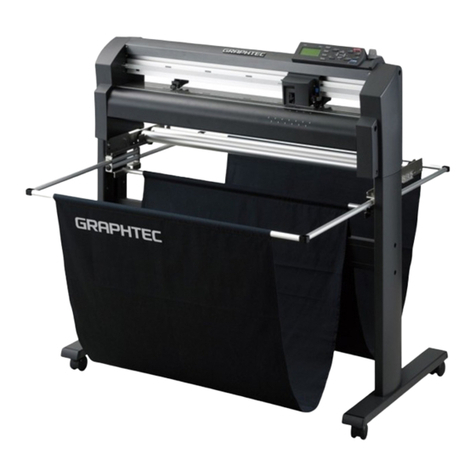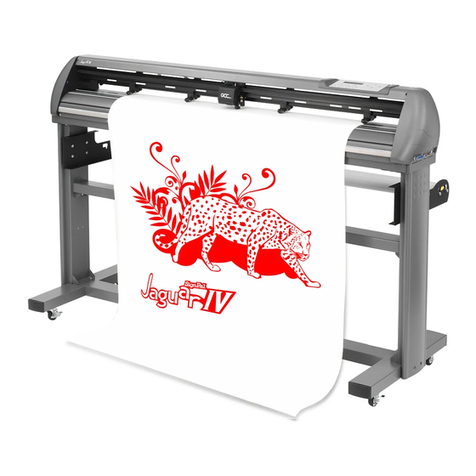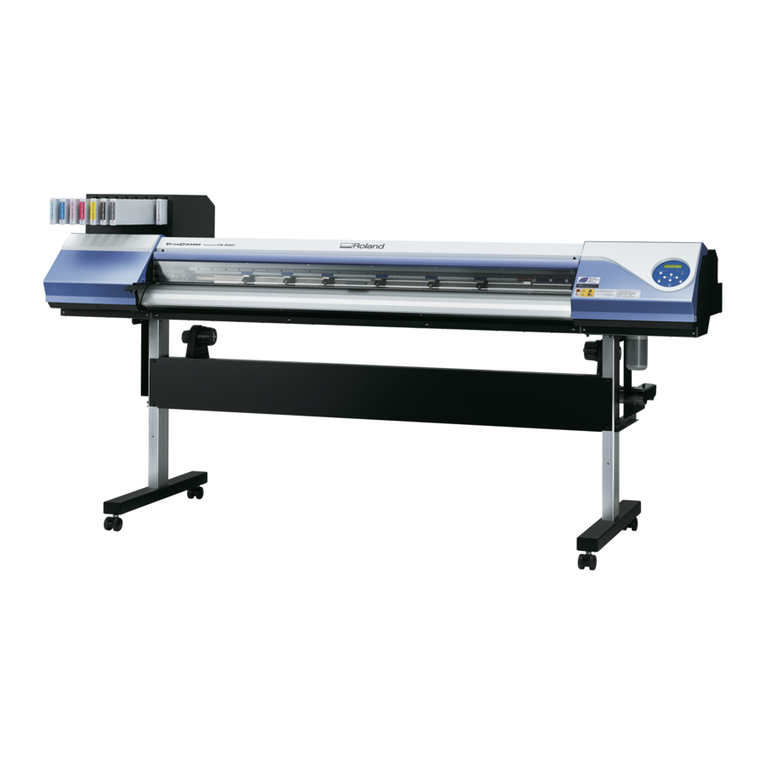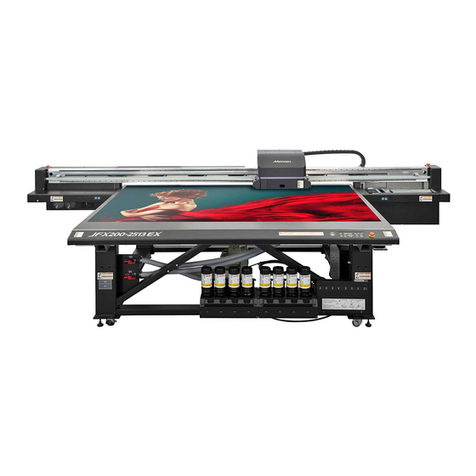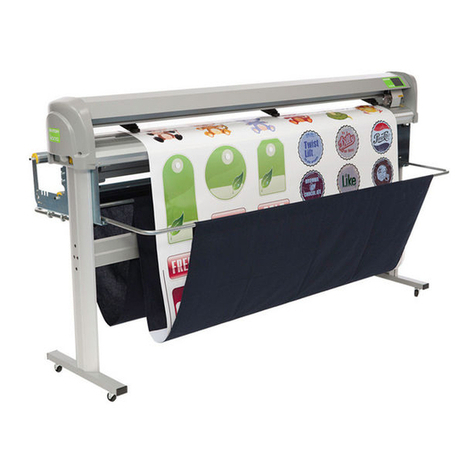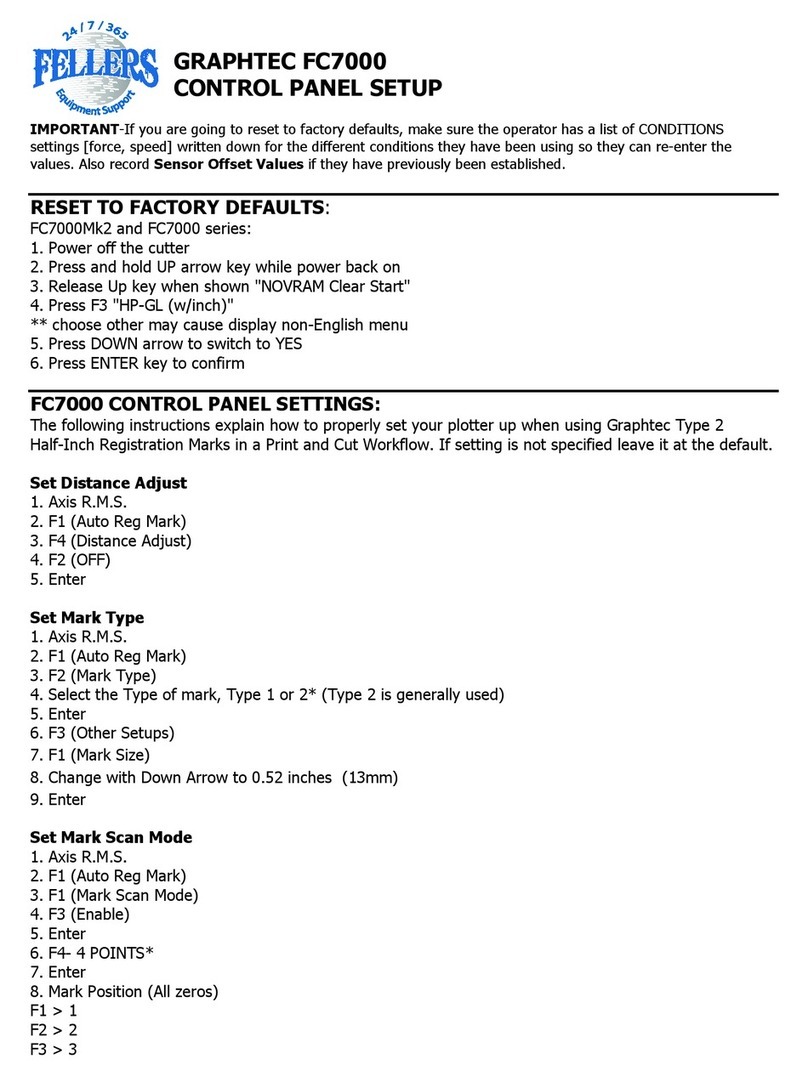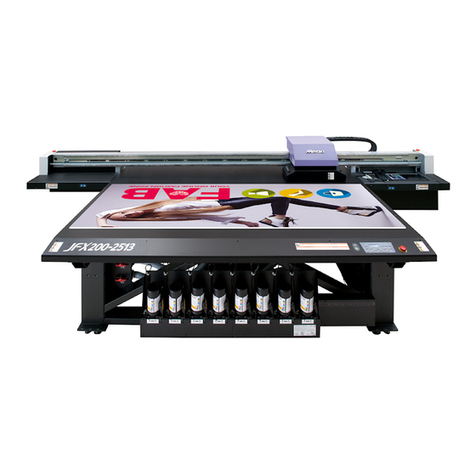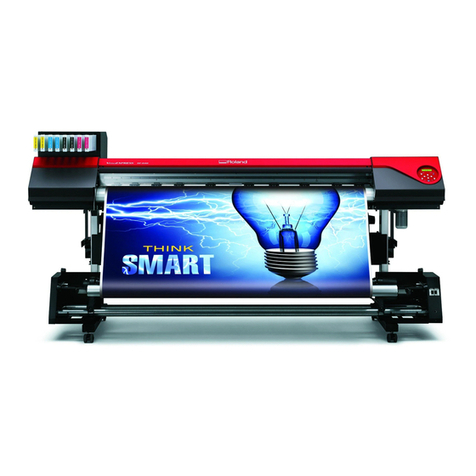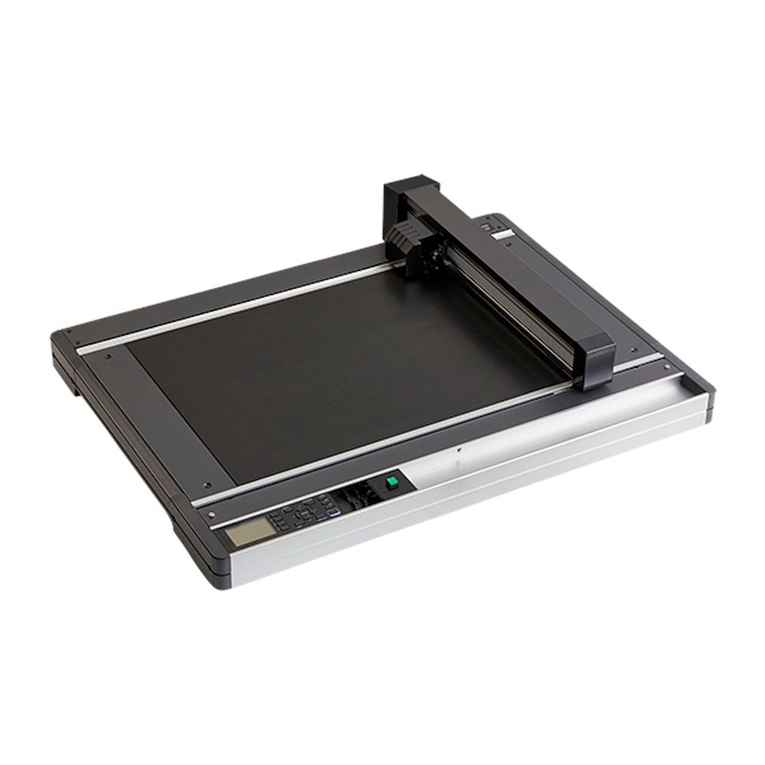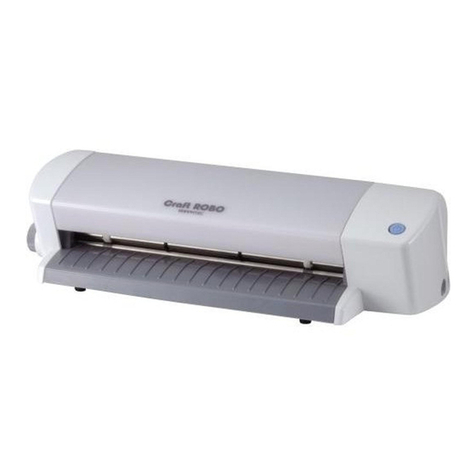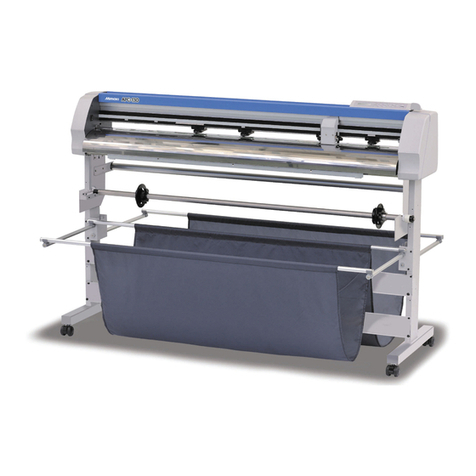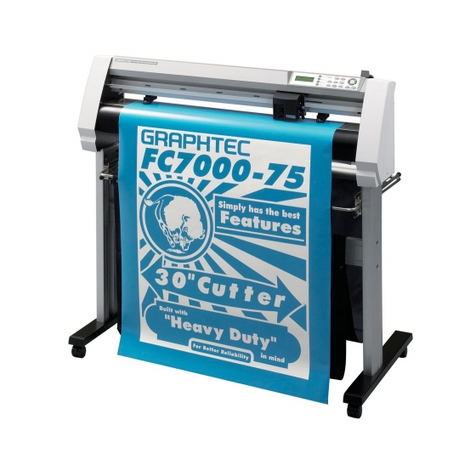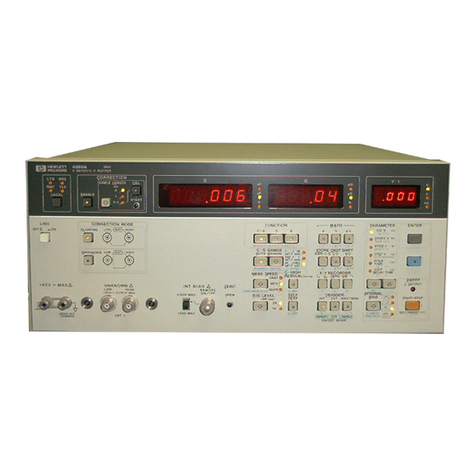Sekonic SPL-450 User manual

INSTRUCTION MANUAL
FOR
X-Y PLOTTER
(A3 Size)

INTRODUCTION
Thank you very much for your purchase of our X
—Y ,plotter.For
correct operation,please read the "
Instruction Manual ".
CONTENTS
1. Standard Accessories
2. Precautions on Operation
3. Names and Functions ofEach Part
4. Preparation for plotting
Interface
6. Example with Computer Communication (RS— 232C)
7. Command
8. Specifications
17
21
23
27

1Standard Accessories
Unpackand verifythat the following
standard accessories are supplied.
1X Y plotter (main unit)
2Power Cord
3 Fiber pen(water type,8colors per set)
4Magnet
5 Soft cover
6 Instruction manual
I pc.
I pc.
I set
1pc.
I pc.
1copy
* Magnet(4)
is not furnished to Electrostatic Paper Holdingtype.
(D
X
—Y plotter (main unit)
@ Magnet
(2)Power cord
Fiber pen(water type,8colorsper set)
(b)
Soft cover
(6)
Instruction munual
If any of the aboveitems is rnissingor damaged, pleaseinform your dealer
ofthis fact immedeately.
2

2 Precautions on Operation
Observe the following precautions for safe operation.
I) Avoid operating or storing the X—Y plotter in a place exposed to direct
sunlight or near a device
generating heat.
2) Avoid operating the X—Y
plotter in a dusty or humid place.
3) Avoid operating the X—Y
plotter in a place with extreme mechanical
vibration or electrical noise.
4) Don't put heavyobjectson the X—Y plotter or lean on your arm or
elbow on it.
5) Install the X
—Y
plotter in as flat a placeas possible.
6) Don
't put a magnetic disc, card, or tape on the X—Y plotter, or these
magnetic productsmay malfunction.
7) Connect the power cable and the interface cable securely. A poor
connectionmay cause a malfunction.
8) Disconnect the power cable when the X—Y plotter is not used for a
long time.
9) Auto pen cap is providedto preventdrying of the pen point. After
operation,remove the penfrom the pen arm and cap it.
10) Don't lubricate mechanical parts. This may cause problems.
11) Use alcohol to remove ink stains from the paper setting table.
Neveruse an organic solventsuch as a thinner.
Special cautions for Electrostatic Paper Holdingtype.
I ) Electrostatic absorption plate is fitted with electrodes. So, sharp or
edged devices shouldnot be used on the plate in order to protectthe
built—in electrodesfrom beingdamaged. Putting heavy itemson the
plate should also be restrained.
2) Surface of the plastic plate shouldbe free from any dirts, otherwise
absorption power will weaken.
If the surface becomes dirty, sweep a brush over the plate and wipe the
dirt off with a wet cloth.
Water or alcohol is recommended to wet the cloth. Organic solvent
like thinner, however, should not be used to prevent the plastic plate
from deterioration.
3) When
transparency film is used as plottingpaper, pleasenoteit is not
so suitable for electrostatic absorption.
—3

3 Names and Functions of Each Part
l) Names of each part
@ Pen cap (8) (5)Pen arm (8) (j) Paper holder
(Cover)
(2)
Guide seal
(Table) (j)Tray
(3)
Magnet(standard accessory) (B)
Control panel
@ Format table (Slide arm)
(B)
Pen holder
Pen No.l
(DDip switch Pen No.8
RS—232C
connector @ Power switch
(b Ground terminal
0 8 —bit
parallel
Centronicsconnector (DPower cord plug
Fig.3—l Names of each part
4

2) Functions of each part
1 Paper holder
This is used to fix the leftside ofthe paper.
2 Guide seal
This is used as a referencefor positioningthe bottom edge of the
paper.
3 Magnet
A standard accessory,usedto fix the right sideofthe paper.
4Pen cap
An auto pen cap to prevent drying of
the pen point during operation.
5Pen arm
Set a pen on this arm. The foremost pen is
pen No. l,
and the
rearmost pen is
pen No.8.
6Pen holder
Set a pen removedfrom the pen arm in this holderfor plotting by
movingon a sheet ofpaper.
7Tray
This is used to
store caps removed from pens.
8Control
panel
This is used for manual external operation.
98—
bit parallel Centronics connector
10 RS — 232C connector
These are the interfaceconnectors
for external input.
Il Dip switch
This is used for setting serial communication
format and character
font.
12 Format table
This is used for setting the dip switch.
13 Power cord plug
This is a powercord connection
terminal.
14 Power switch
This is
used to
turn ON and OFF the X —Y plotter.
15 Ground terminal
This is used to connecta ground cord.
* Paper holder O and Magnet O are not furnished to ElectrostaticPaper
Holdingtype.

4 Preparation for Plotting
Prepare for plotting according to l,he
followingprocedure.
D
2)
(1)
(2)
Paper holder
Installation
Install the X Yplotterin as flat a placeas possible.
Paper setting
Magnetic Paper Holding type.
Raise the paper holder,and insert the left edge of the sheet of paper.
Theleftedgemeetsthe paperguide. At this time, the bottomedge
of the paper should be evenalong the guide rail. Secure the right
sidewitha magnet.
Electrostatic Paper Holding type.
Push PAPER HOLD key on the control panel and confirmif
lamp is on. This light showsthat the functionof electro-
static paperholdworkseffectively.
Paper should be so set that its leftedge shall fit to the leftend of
the plate and its bottom edge to the guide seal. In this case, a
bindingmargin of approx. 12mm
widthis reservedon the left edgeof
paper, and this marginal spaceis freefrom the effect
ofelectrostatic
absorption.
If the paper waves
on the plate,
make it even
by the palm of hand.
By pushing PAPERHOLD keyagain, P. HOLD lamp is turned
off, and absorptionis released.
P•per guideGuide sealP•per Guide sealP.per
P.p.r bolder
Paper
.jong guid•
•ions guide
MagneticPaper IloldingCY1)e. Electrostatic Paper Holding type.
6

3) Paper sizeand plottingarea
ANSI/A,ANSI/B,ISO/A4
and ISO/A3sizes are usable in this plotter.
Use the dip switch on the rear panel for setting the plottingarea for each
size of paper.Refer to 8) Setting the dip switch.
Set each size of paper accordingto 2) . The plottingarea and ziro
point position are differentfor each size of paper. Therefore,set
the same
paper size as the paper to beused.
Table 4— 3 shows the relationship between the size of paper set/
selected and the plotting area.
Dip Switch setting
SWI-8 -9
ON ON
ON OFF
OFF ON
OFF OFF
Paper size selected
ANSI/A inches
ANSI/ B 17x 11 inches
ISO/A4 297x210 mm
ISO/A3 mm
Plotting area
266.800 x 199.050
416.000 x 260.200
277.000 x 193.000
404.000 x 277.000
mm
mm
mm
mm
Table 4—3 Paper size and plotting area
The table shows the relationshipbetween
the paper size,the plotting
area, and the zero point.

o
199. 050 mm
ANSI/
A size paper
Origin of coordinates
Fig.4—4
Coordinate origin and plotting area for ANSI/A size paper
ANSI/B size paper
o
o
o
O
o
o
o
Origin of
coordinates
416. 000 mm
Fig.4—5 Coordinateorigin and plotting area for ANSI/Bsize paper
8

ISO/A4 size paper
193.
000mm Origin of coordinates (0, 0)
Fig.4—6 Coordinate origin and plotting area for ISO/A4size paper
ISO/A3 size paper
Origin of coordinate 404. 000 mm
Fig.4—7
Coordinate origin and plotting area for ISO/A3size paper

4) Kind of paper
Coated paper,fine quality paper, and measuring paper are usable.
We recommend coated paper that produces minimal ink blurring. Use an
oil pen when using a film sheet for an OHP(OverheadProjector).
5) Pen setting
Removethe cap,and insert the pen into the pen arm. Insert the pen
point into the pen cap,and insert the flange into the pen arm slit. If the pen
is inerrorly set,the pen can't be exchanged or the pen point may be
damaged.
slit
Pen cap
(X)
Remove the cap.
@ Correct setting
Fig.4—8
Pen setting
Pen arm
Pen flange
(2)
Insert the pen point (3)Insert the pen flange into
into
the
pen
cap. the pen arm slit.
O
x
(b)
Incorrect setting
The removed cap should be stored or put in the tray so it is not lost.
Whenthe X
—Y
plotter is not used for a long time,be sure to remove the pen
from the penarm and put the cap on it.
10

6) Powerconnection
and operation
1 Verify that the powerswitch is—off.
-Insert the-powencable—into the
power cord plug,and connect
the other end of the powercable to the
AC outlet.
2 Connect
the interfaceconnector. For eachformat setting,refer to 5
"Interface " .
3 Set the paper, and set thepens.
At this time, don't set a pen in the pen holder. Otherwise,
the pen
sensor functions after the poweris turned ON,andthe X—Y plotter
producesan error with the ALARM
lamp flashingred on the control
panel. If
this
conditon occurs,return the pen to the unused pen arm
and turn on the power
again.
4 Whenthe powerswitchis turned ON,the
POWERlamp is lit on the
control panel and the pen holder moves until detecting the limit
positionsin the X and Y directions.
5 The operation can be checked
from the control panel. Details are
described in the next section.
6 Whenthe plottingcommandis entered,fthe
plottingis started with the
specifiedpen.
When neither the plotting command nor the command from the
controlpanel is enteredfor 10
seconds,
thepenis automaticallystored
in the
pen arm.
—11—

7) Description of the control panel
The switches and lamps on the control panel and their functions are
described.
— POWER
— P.HOLD
— ALARM
PAPER
HOLD
— POWER
— ALARM
PEN ENTER
PEN
PENT DOWN
PEN5
PEN4
PEN2
ENTER PEN8
PEN6
PEN3
PENI
Electrostatic Paper Holding type.
PENT
PEN5
PEN4
PEN2
PENI
UP/DOWN PEN8
PEN6
PEN3
Magnetic Paper Holding type.
PEN
oUP/
DOW PEN UP/DOWNkey and lamp
• When
this key is pressed, the pen state(up or down)is inverted.
• Whenthis key is pressed during program execution,the same effectas
executionof a"PU"or"PD"command can be obtained.
• The lamp flashes green whenthe pen is moveddown.
12

ENTER ENTER
KEY
• Whenthe "DP"command is received,
the ALARMlamp flickers. When
the pen is movedto a desired point and the NT
E Key is pressed,
the ALARM lamp stops flickeringand the coordinate
valueof that point
and the pen state are stored in the output buffer of the X—Y
plotter.
This data is sent to the computerwhenthe "
OD"command
is received.
• Whenthe [ET] or [PE] key is pressed togetherwith the
key,the current pen positionis definedas a newscaling point PI or P
2.
P2 moves with Pl.
• When the [i] key is pressed together with the key,the
coordinate system is rotated90
0
When the key is pressed together with the
key,all functionsare reset to theinitial state.
PI , P2Key
• Whenthe or key is pressed,the pen rises and movesto the
scaling point PI or P2set then.
• Whenthe key is pressedtogetherwith the or key,
the current pen positionis set as a newscalingpointPI or P2
• These four keys are used to move
the pen within the plottinglimit. The
pen movesin the direction of the arrow on the pressed key.
• Whentwo adjacent keys are simultaneously pressed, the pen movesin
the resultant direction (450
) of the two arrows ofthese keys.
• When
the keyis pressed,the penmoves
first at a lowspeed
for 1.5
secondsand then, it movesat a high speed (4times faster than the low
speed).
13

• Pause function.
Bypressing any of the arrow keys while program is executed, theopera-
tion stops temporarily and-thepen returns to the pen—up
position.
To release the pause mode, press any of the arrow keys again. Whilethe
plotter remains in the pause mode, the MANUAL
RESETis available.
POWERlamp
• This turns red when the poweris turned ON.
ALARM lamp
• This flashes red when an error occurs in the plotter. It indicates
detection of an I/O error not set in the error mask or an error
concerning the command.
• The lamp flickersduring digitizingafter receivingthe "DP"command
and until is
pressed.
PAPER
HOLD
• Pushing this keyturns on the PAPER HOLD
lamp and puts electrosta-
tic -paper hold into operation.-Push-ing
this again turns offthe PAPER
HOLDlamp and releases electrostaticpaper hold.
P.HOLDlamp
• While this lamp is on, electrostatic paper hold works. Pushing the
key turns on this lamp and pushing the key again turns
it off.
Pen selection
While the plotter is not in operation, a pen can be selectedby manual
operation.
Press the keywhiledepressing the ENTERkey.
WhenALARMindicator starts blinking, release both keys.
Then press the controlpanel keycorrespondingto the number of the
pen to be used. For example, pressing key selects pen l. (see
Figure in page 12).
If the selectedpen is not used within approx. 6 seconds, it is automati-
callyreturned to its penstall to preventit from drying.
14

8) Settingthe dip switch
Two dip switches are providedon the rear panel. Set them
appropriately before turning on the power switch.
The SWI determines the communication
methodof the RS—
232
C
interface. The SW2determines the default value of the character font. The
upper side is "ON", the lower side is "OFF",and the left side is No.
1. The
setting
detailsare as shown
below.
At shipping
Switch No. Item
1-3 Baud
rate setting
ON OFF
See below from factor
9, 600 baud
4
5
6
7
8
9
10
Baud
rate
150
300
600
1200
2400
4800
Stop bit
Parity
Buffer size
Paper size
Unused
No.l
ON
OFF
ON
OFF
ON
OFF
ON
2
Yes
Even
5Kbytes
ANSI(US)
No.3
ON
ON
ON
ON
OFF
OFF
OFF
1
No
Odd
1Kbyte
ISO(MET)
A3/B
1
No
Odd
1K
byte
ISO
A3/B
No.2
ON
ON
OFF
OFF
ON
ON
OFF
9600

No
No. 5
No. 6
No. 8
No.10
Set O
Set 6
Set 8
Set 9
Set 30
Set 31
Set 32
Set 33
Setthe baud rate.
Selectwhetherthe stop bit is Ior 2bits.
Selectwhetheror not the parity bit exists.
Selectevenor odd partity when
the parity bit exists(No.5)
Unused
Used in combinationwith switchNo.9
for setting the paper size
to be used. The paper sizeis selectablefrom the followingfou
r types.(Refer to page 7.)
5
inches)
inches)
This switchis used to select ISO(MET).
Usedto selectA3/Bor A4/Aofthe four paper sizeslisted above
(No.8). (Refer to page 7.
)
Unused
Font
(ANSI ASCII)
(JIS ASCII)
(katakana)
(ISOIRV)
(ISOSwedish)
(ISOSwedish For Names)
(ISO Norway, Version 1)
(ISOGerman)
No.l
ON
OFF
ON
OFF
ON
OFF
ON
OFF
No.2
ON
ON
OFF
OFF
ON
ON
OFF
OFF
No.3
ON
ON
ON
ON
OFF
OFF
OFF
OFF
No.4
ON
ON
ON
ON
ON
ON
ON
ON
Set 34 (ISO French)
Set35(ISO United Kingdom)
Set 36 (ISO Italian)
Set
37(ISO Spanish)
Set
38
(ISO Portuguese)
Set 39(ISO Norway, Version 2)
ON
OFF
ON
OFF
ON
OFF
ON
ON
OFF
OFF
ON
ON
ON
ON
ON
ON
OFF
OFF
OFF
OFF
OFF
OFF
OFF
OFF
—16

5Interface
DInterface switching
Two interfaces are provided, an 8—bit
parallel Centronics interface
and RS—232C
interface. These interfaces are automatically switched. The in
terface that receives a signal first after the poweris turned on is selected.
2) 8—bit
parallel interface (conformableto Centronics)
O) Control signal
ST
BBUSY ACK ERROR
Input/output circuit
configuration and input/output condition
Input/output logic level
4.
7k Q
DATA 1
74 HC 132
STB oo —1.35 v
1000 1500
PF
Output logic level
4. 7kQ 7406
BUSY
ACK
ERROR
Timing chart
0vsor more
DATA
S
TB
0.1 or less
BUSY
ACK
0.5gsor more
Data holding time
0
.5gsor more
0. vsor more

Input connector
Cable side : DDK 57—
30360or the equivalent
Main unit side : DDK 57—40360 or the equivalent
(b) Connector signals and functions
Pin Signal
STB
2DATA I
3DATA 2
4DATA 3
5DATA 4
6DATA 5
7DATA 6
8DATA 7
9DATA 8
10 ACK
11 BUSY
12 GND
13
14
15
16 GND
17 E.G.
18
19 GND
30
31
32 ERROR
33 GND
34
35
36
Direction
Input
Input
Input
Input
Input
Input
Input
Input
Input
Ou tput
Ou tpu t
Ou
tput
Function
Strobe pulse, Pulse width of0.5/LSis required.
Usually "HIGH" in input, and takes in the data at
the trainling edge.
8—bit
data signal. HIGHlevelat logical "1", and
LOW at "0"
Acknowledge
output. Pulse width is about 0. 5gs.
This indicates that the data has been received.
When
this signal is HIGH,it indicates that the
plotter can't receive
a signal. This signal is HIGH
in the followingconditions:
(l)Data input period
(2)
Under plotting
PULL UP to 5V
Inhibited from use.
GND
for returning to
Whenthis signal is LOW,it
indicates that the plotter
is m an error condition.
18

3) RS-232C Interface
(D Synchronizing system
Start—stop
system
@ Communicationspeed(baudrate)
150, 300, 600, 1200, 2400, 4800, 9600
($) Communicationformat
Start bit:
I
bit
Data:8—bit or 7—bit
Parity:Even,odd,or no parity
Stop bit:1or 2bits
@ Buffermemory size
1024
bytes/5120 bytes
(Convertibleby DipSwitch).
(D Input/output circuit
configuration and input/output characteristics
75189 ON(SPACE) : + O"
OFF(MARK): -5
+
12V 75188 ON (SPACE) :
OFF
(MARK)
: -
-12V
(D Input/output
connector
• Cable side
EIA standard 25-pin plugtype(JAE DB-25P
or theequivalent)
• Plotter side
EIA standard 25-pin socket
type(JAB DB
25S
or the equivalent)
—19—
Table of contents
